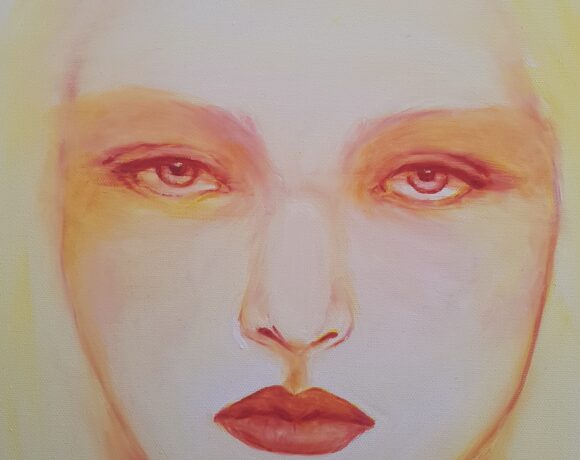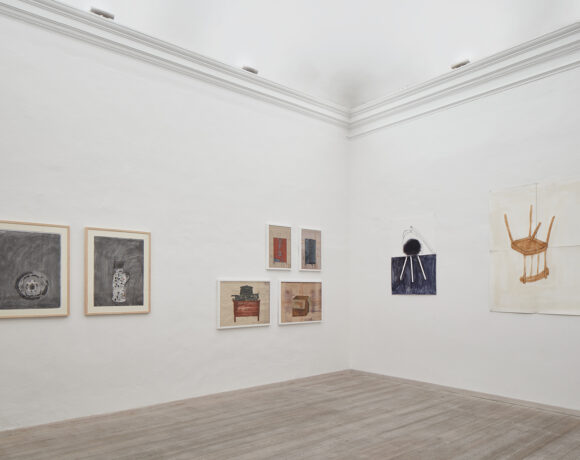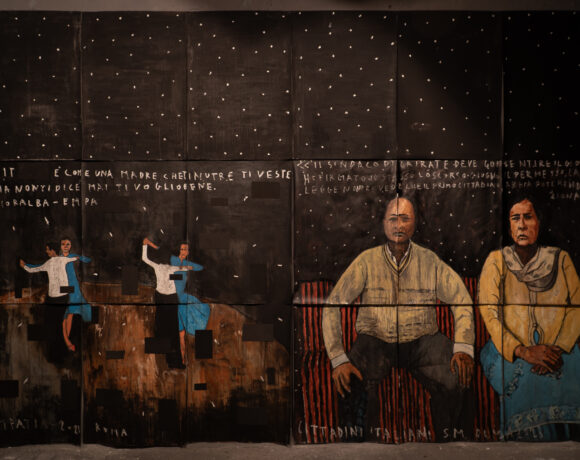The Lorcan O’Neill Gallery has opened its doors to host the solo exhibition of one of the leading exponents of the Italian artistic scene of the Seventies.
Born in Turin in 1936, where he still lives and works, Giorgio Griffa, after an initial traditional approach to painting, from 1960 has been trained by Filippo Scroppo, an abstract painter from the school of Felice Casorati. With his own artistic sensibility, he fully placed himself in the climate of the time, however, deciding to remain above the rigid frameworks of some of the strongest trends of that moment.
In order to fully understand Griffa’s transversal research and to contextualize his personality, it is necessary to recount the fervent context in which he began. His activity is situated in that radical period, produced by the instability of the post-war years and the consequent political and social upheavals, in which art underwent an extraordinary transformation. Let us think, for example, of Jackson Pollock and of his large canvases realized with the drippingtechnique: with the cancellation of figuration through a simple gestural activity and the relationship of non-absolute prominence of any area of the work, the classical pictorial style was completely abandoned. No more the act of painting with easel and canvas, almost no more the meditation that always, for many, represented the divergence between photography and painting, but a creative gesture and jet that highlights the essence and self-referentiality of painting. These were new visual and experiential practices that, by confining the figurative datum and highlighting the creative process, did not require mediation.
Let’s focus on Griffa. In Italy, in the second half of the Sixties, Germano Celant shifted the audience’s attention to Arte Povera: that new attitude that devalued the artistic object by virtue of the creative process and the artistic action. Giorgio Griffa, who came into contact with some representatives of Arte Povera, was certainly influenced by it in some way, but he developed his own language outside of this trend.
The artist was also associated with Minimalism and approached Analytical Painting, but he always maintained the will to remain autonomous and free from any subordination. In fact, referring to the group of analytical painters he declared, “stable horses but loose dogs.”
The exhibited works in the large space of the Lorcan O’Neill Gallery reveal some assonance with these trends and show a wide range of research: three groups of works belonging respectively to the seventies, the eighties while, those located in the second room belong to more recent years (2019-2021). The raw canvases, devoid of any support, line the walls of the gallery allowing the viewer a close and absolutely immersive approach. The colors, which seem to enter the support without invading it, and yet master the canvas through large brushstrokes and signs, seem light touches and they give the observer a pleasant feeling of suspension.
In Griffa, one can find not only the will to study and adopt the conditions of materials and colors, but also an extreme and continuous desire to freely experiment with the deeper side of art, which is often divergent from the formal component, which in him is set aside. There is the intention to probe, through the pictorial traces, the most hidden and reserved world, the gnoseological aspect of art. Yet, there is no obvious personal aspect in these canvases, perhaps they are the translation of an intimate need, but it is as if they remain available to the changing investigations of the viewer.
The work embraces Griffa’s gestural expressiveness, translating the truth of colors in the best possible way, without frills. But what is most interesting in the artist’s research is his desire not to master art, not to bend it to his own needs, but on the contrary his ability to translate what art and the materials ask him. This is the essence of Griffa’s research, which is thus free and potentially infinite.
Claudia Pansera
Info:
Giorgio Griffa
Lorcan O’Neill Gallery, Roma
22/02/2022 – 22/04/2022
mail@lorcanoneill.com
+39 06 6889-2980
 Giorgio Griffa, Obliquo, 1976. Acrylic on canvas, 80 x 77 cm. Courtesy of Lorcan O’Neill Gallery
Giorgio Griffa, Obliquo, 1976. Acrylic on canvas, 80 x 77 cm. Courtesy of Lorcan O’Neill Gallery
 Giorgio Griffa, Campo Giallo, 1986. Acrylic on canvas, 147 x 112 cm. Courtesy of Lorcan O’Neill Gallery
Giorgio Griffa, Campo Giallo, 1986. Acrylic on canvas, 147 x 112 cm. Courtesy of Lorcan O’Neill Gallery
 Giorgio Griffa, Campo Giallo,1984. Acrylic on canvas, 175 x 397 cm. Courtesy of Lorcan O’Neill Gallery
Giorgio Griffa, Campo Giallo,1984. Acrylic on canvas, 175 x 397 cm. Courtesy of Lorcan O’Neill Gallery

Born in Reggio Calabria in 1998. In Rome she graduated in Historical-Artistic Studies with an experimental thesis on the artist Nik Spatari. She has written for some magazines and is currently a student of the master’s degree course in Art History. She appreciates art in every declination and loves to tell it.






NO COMMENT